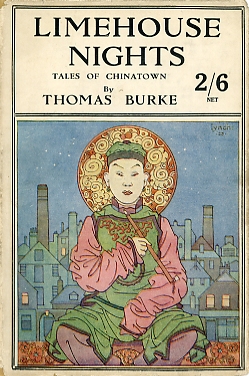
|
Limehouse Nights
Grant Richards edition
1923 (7th) printing
Front of jacket
Painting by Lynch
|
|
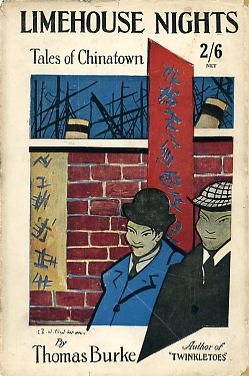
|
Limehouse Nights
Grant Richards edition
1923 (7th) printing
Back of jacket
Painting by C.R.W. Nevinson
|
|
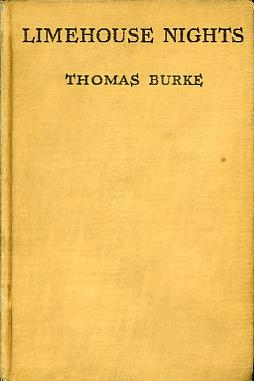
|
Limehouse Nights
McBride edition
1919 (8th) printing
|
|
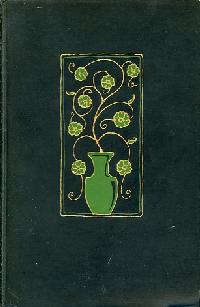
|
Limehouse Nights
Illustrated by Mahlon Blaine
1926 McBride edition, cover
|
|
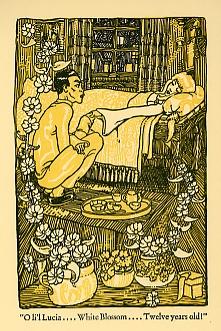
|
Story: "The Chink and the Child"
"O li'l Lucia . . . . White Blossom . . . . Twelve years old!"
Illustration by Mahlon Blaine
1926 McBride edition, frontispiece
|
|
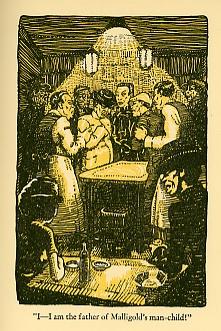
|
Story: "The Father of Yoto"
"I -- I am the father of Malligold's man-child!"
Illustration by Mahlon Blaine
1926 McBride edition, page 35
|
|
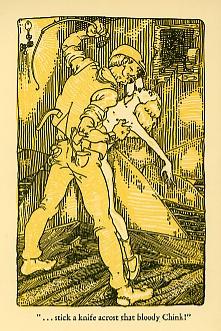
|
Story: "The Paw"
". . . stick a knife acrost that bloody Chink!"
Illustration by Mahlon Blaine
1926 McBride edition, page 66
|
|
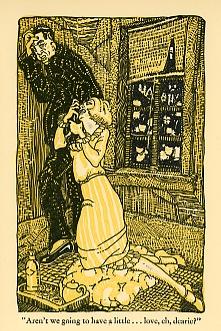
|
Story: "Tai Fu and Pansy Greers"
"Aren't we going to have a little . . . love, eh, dearie?"
Illustration by Mahlon Blaine
1926 McBride edition, page 143
|
|
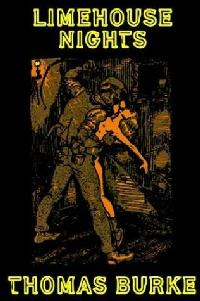
|
|
2006 Wildside edition
|
|
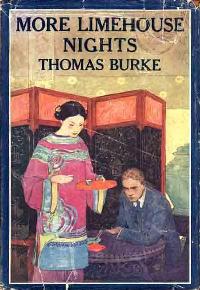
|
More Limehouse Nights
New York: George H. Doran, 1921
American edition of
Whispering Windows
London: Grant Richards, 1921
|
|
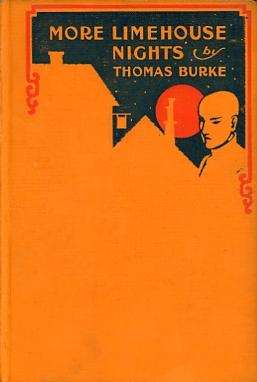
|
More Limehouse Nights
New York: George H. Doran, 1921
|
|
Limehouse Nights
UK editions
Limehouse Nights: Tales of Chinatown
London: Grant Richards, 1916
311 pages, hardcover
1st printing, 1916
7th printing, 1923
Illustrator: C.R.W. Nevinson
Front of jacket: Lynch
Back of jacket: C.R.W. Nevinson
Broken Blossoms
(A Selection of Stories from 'Limehouse Nights'
London: Grant Richards, 1920
184 pages, hardcover
Special movie tie-in edition included:
"The Chink and the Child"
"The Gorilla and the Girl"
"Beryl, the Croucher and the Rest of England"
"Tai Fu and Pansy Greers"
"Gina of the Chinatown"
"The Paw"
Limehouse Nights: Tales of Chinatown
London: Brown, Watson Ltd, ? year
? pages, paperback (digit books series ?)
US editions
Limehouse Nights
New York: Robert M. McBride & Company, 1917
311 pages, hardcover
1st printing, August 1917
8th printing, July 1919
17th printing, April 1927
Limehouse Nights
Illustrated by Mahlon Blaine
New York: Robert M. McBride & Company, 1926
277 pages, hardcover
Frontispiece and 13 illustrations
Stories
The Chink and the Child
The Father of Yoto
Gracie Goodnight
The Paw
The Cue
Beryl, the Croucher and the Rest of England
The Sign of the Lamp
Tai Fu and Pansy Greers
The Bird
Gina of the Chinatown
The Knight-Errant
The Gorilla and the Girl
Ding-Dong-Dell
Old Foe
Whispering Windows / More Limehouse Nights
UK editions
Whispering Windows: Tales of the Waterside
London: Grant Richards, 1921
309 pages, hardcover
Whispering Windows: More Limehouse Nights
London: Cassell and Company, 1928
309 pages, hardcover
US editions
More Limehouse Nights
New York: George H. Doran Company, 1921
282 pages, hardcover
Stories
The Yellow Scarf
A Game of Poker
Katie the Kid
The Heart of a Child
The Dumb Wife
Bluebell
A Family Affair
The Little Flowers of France
The Perfect Girl
The Affair at the Warehouse
Big Boy Blue
Mazurka
The Scarlet Shoes
The Good Samaritans
Twelve Golden Curls
Miss Plum-Blossom
The Cane
The Song of Ho Ling
Censorship of Limehouse Nights
Limehouse Nights seems to have a difficult birth and a precarious infancy. According to one antiquarian book dealer, the collection of stories was rejected by twleve publishers before Grant Richards agreed to produce it (James Cummins Bookseller, New York, Abebooks.com).
The book and Burke were harshly criticized, according to Anne Witchard, a lecturer at Birkbeck College, University of London, who has been doing research on images and perceptions of China in popular culture in the early twentieth century, and is working on a book about Thomas Burke and cultural perceptions of London's Limehouse at the time he wrote Limehouse Nights: Tales of Chinatown. In one recent journal article, she wrote (Witchard 2004):
Thomas Burke's best-selling collection of Chinatown love stories, Lime house Nights was published in 1916 to instant notoriety. Whilst the book received laudatory reviews it was banned for immorality by the national subscription libraries. Burke caused outrage by his misappropriation of the underworld of establishment concern: "In place of the steady, equalised light which he should have thrown on that pestiferous spot off the West India Dock Road," protested the Times Literary Supplement, "he has been content ... with flashes of limelight and fireworks."[1] [The Times Literary Supplement, 28th September, 1916, p. 464. Unattributed book review.]
In a more recent article, following this same observation, she went on to note (Witchard 2005):
At the same time Burke received letters of support and encouragement from literary luminaries, amongst them H. G. Wells, Ford Madox Ford, Eden Philpotts and Arnold Bennett. [note 2] Some thirty years later, in his preface to a posthumous publication of Burke's Best Stories, the poet John Gawsworth found it difficult to imagine at a time
when James Joyce's Ulysses is issued, and reissued in London . . . that the accouchement of Limehouse Nights -- surely some occasion in modern literary history? -- was attended by acute anxiety both for the author and the publisher, that "Arnold Bennett told Burke that the possibility of securing a conviction was being seriously discussed at headquarters, and that he himself feared the worst." But so it was. For feelings still ran high at that time against frankness in fiction. [note 3]
So what was it, muses Gawsworth disingenuously, that had "occasioned the pother?"
The sadistic motif underlying so many of his themes? No I do not think so: but would suggest, rather, that it was the novel, and to most unsavoury, implication that Yellow Man cohabited with White Girl in that East End of an Empire's capital surrounding Limehouse Causeway. [note 4]
C.R.W. Nevinson's "Limehouse"
C.R.W Nevinson (1889-1946), best known for his angular paintings of the Great War, represented the geometric, Cubist, Futuristic movement in contemporary art. Among his works is a painting called "Limehouse" (1919), and an illustration for the back cover of an early edition of Burke's Limehouse Nights: Tales of Chinatown.
Urmila Seshagiri, a professor of English at the University of Tennessee, has written that "the geography of Limehouse lent itself to the distopic, angular vision of the avant-garde painter C. R. W. Nevinson, who depicted the district's shadowy buildings in his 1919 Vorticist painting Limehouse" (Seshagiri 2006).
References
|
Urmila Seshagiri |
|
2006 |
"Modernity's (Yellow) Perils: Dr. Fu-Manchu and English Race Paranoia"
Cultural Critique (University of Minnesota Press)
Number 62, Winter 2006, pages 162-194
|
|










